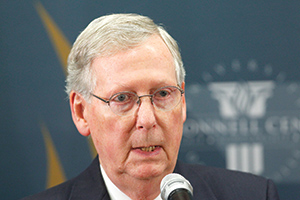Federal Officials, Union Seek Fix For Central States Pension Fund

This story appears in the June 20 print edition of Transport Topics.
Legislative and regulatory efforts to address financial troubles with union pension funds are continuing in the aftermath of the Central States Pension Fund’s unsuccessful effort to rescue its plan by slashing most retirees’ benefits by 50% or more.
On the regulatory front, the federal Pension Benefit Guaranty Corp. has published a proposal that could allow troubled funds, such as Central States, to merge with more solvent ones to stave off benefit cuts.
Meanwhile, 20 Democrats are waiting to hear from Senate leadership about their request to advance pension issues legislatively before the mid-July congressional recess.
Also, John Murphy, Eastern region vice president of the Teamsters union, told Transport Topics that the union is working with key House and Senate members on a plan that will be announced “very soon” to provide a new source of pension funding that is not directly dependent on government funds. He didn’t specify when the plan would be announced. There also is the possibility that the New York State Teamsters Fund could decide to file a rescue plan.
Those developments followed the May 6 rejection of the Central States’ plan by the U.S. Department of the Treasury.
Central States, the largest Teamsters pension fund, with more than 400,000 participants, was required by the 2014 Multiemployer Pension Reform Act to submit a rescue plan to address an asset drain of $3.46 in benefits paid for every dollar collected. Central States declined to offer a new plan, and now it says that only Congress can save the fund.
“The pension issue is like a runaway freight train,” Murphy said, which must land in Congress’ lap because the issue hasn’t been addressed for decades while funds dwindled.
On Capitol Hill, there was no immediate indication the Senate would act on pension issues before the July 18 recess date. Democrats last month asked Majority Leader Mitch McConnell (R-Ky.) to address miners’ and truckers’ pensions before the recess. A separate pension fund for retired miners is in danger of insolvency this year unless Congress intervenes, according to the Democrats’ letter.
McConnell spokesman Robert Steurer told TT last week that the next action, if any, would have to come from the Finance Committee. A committee spokeswoman didn’t respond to requests for comment.
McConnell “continues to believe [pensions are] a very important issue that deserves open, transparent debate through the regular order committee process,” his spokesman said.
The proposal from the Pension Benefit Guaranty Corp., which is open for comment until Aug. 5, includes four requirements: 120 days’ notice to PBGC, no lowering of benefits immediately after a merger, no reasonable expectation of insolvency at the time of the merger and the need for an actuarial assessment of both plans.
“Plan mergers can make multiemployer pensions more stable and secure,” PBGC Director Tom Reeder said in a statement. “PBGC can help save troubled multiemployer plans before they fail. That helps plan participants and reduces the long-term costs of the pension insurance program.”
According to the Pension Benefit Guaranty Corp., more than a million people are in the most troubled pension plans. Central States represents about 40% of that total.
The PBGC proposal also includes the prospect of financial assistance by the agency to facilitate mergers, though its resources are strained to the point that its funding is uncertain after 2025. That aid could be a maximum of $60 million annually for three years, far short of Central States’ needs because its annual shortfall was about $2 billion last year.
Murphy also said PBGC’s own plight has been widely overlooked.
“That is something people have to come to grips with,” he said.
“The irony is that all of the critics of the Treasury Department [over the Central States decision] have ignored the potential insolvency of the PBGC,” Murphy said, adding that negative comments about the decision illustrate how little they understand the underlying issues.
The federal agency is in danger of running out of money as soon as next year to backstop failing multiemployer pension plans if the miners’ pension plan becomes insolvent at year-end, Murphy said.
The New York State Teamsters Fund, with about 35,000 participants, is less than 50% funded and pays $2.65 in benefits per dollar contributed. In a letter to members, retiree representative Tom Baum said the New York fund has been considering a benefit-reduction filing in late summer.
“While it’s uncertain, the Central States rejection may make things harder for our fund,” Baum wrote, because the Treasury Department’s rejection of the Central States proposal was based in part on that fund’s overly optimistic assumptions of returns on its investments.
In addition, a Boston area local is on strike against a roofing supplier to dramatize pension complaints.
Teamsters Local 25 President Sean O’Brien said that the company “is intent on destroying their retirement security and passing on health care costs to the workers.”




